Latest recommendations
| Id | Title * | Authors * | Abstract * | Picture * | Thematic fields * | Recommender | Reviewers | Submission date | |
|---|---|---|---|---|---|---|---|---|---|
04 Apr 2025
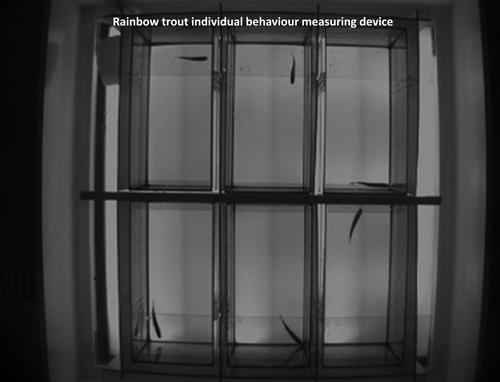
Screening for links between behaviour and acute hyperthermia and hypoxia resistance in rainbow trout using isogenic linesHenri Lagarde, Delphine Lallias, Florence Phocas, Lionel Goardon, Marjorie Bideau, Fanch' Guyvarc'h, Laurent Labbé, Mathilde Dupont-Nivet, Xavier Cousin https://doi.org/10.1101/2023.10.19.563047Advancing sustainable aquaculture: behavioral insights for climate-change resilient fishesRecommended by Nicolas Bedere based on reviews by 2 anonymous reviewers based on reviews by 2 anonymous reviewers
The study by Lagarde et al. (2025) is part of efforts aiming to meet the challenges of adapting livestock farming, and more specifically of aquaculture, to the effects of climate change. In fact, during heat waves, water temperatures rise and oxygen becomes scarce. Fish have to adapt to these conditions of hyperthermia and hypoxia. Studies have already shown that it is possible to genetically improve these resistances in salmonids (e.g. Debes et al., 2021). However, current methods for phenotyping these resistances rely on exposing fish to extreme conditions until they lose equilibrium, which indicates that the animal experiences severe conditions and raises ethical and animal welfare concerns. From the aforementioned, there is then a strong interest in using and identifying less invasive phenotypes, such as behavioural changes, that could serve as indicators of fish responses to hyperthermia and hypoxia. Some behaviours show promise in both wild (Campos et al., 2018) and farmed fish (Van Raaij et al., 1996). A former study by the authors of this manuscript suggests that some of these behaviours are sufficiently heritable to consider applying selection on them (Lagarde et al., 2023). Therefore, the main aim of the present study was to test whether behaviour can be used as an indirect selection criterion to improve the adaptation of rainbow trout to heat waves. To achieve this lofty goal, the responses of different isogenic lines of trout to hyperthermia and hypoxia were investigated using new criteria based on behavioural responses and the reference measure of loss of equilibrium. The results suggest that certain behavioural traits, such as distance travelled and frequency of zone changes, are associated with resistance to these stresses. Moreover, moderate correlations were observed between certain behavioural variables and resistance to hyperthermia. Indeed, lines that were more resistant to hyperthermia had lower distance travelled and frequency of zone changes during the behavioural test. Other significant and positive correlations were observed between acute hypoxia resistance and certain behavioural variables, likely distance travelled, frequency of zone change and percentage of time spent moving. These results pave the way for less invasive methods in assessing hyperthermia and hypoxia resistance based on behavioural observations, which could improve the resistance of farmed fish in response to climate change. The study further allows refining the measurements carried out on candidates for selection in order to improve their welfare during evaluation tests. In conclusion, this study is commendable for its thematic relevance, originality and the potential application of its results to genetic selection of farmed fish.
References Campos DF, Val AL, Almeida-Val VMF. 2018. The influence of lifestyle and swimming behavior on metabolic rate and thermal tolerance of twelve Amazon forest stream fish species. Journal of Thermal Biology 72:148–154. https://doi.org/10.1016/j.jtherbio.2018.02.002 Debes P V., Solberg MF, Matre IH, Dyrhovden L, Glover KA. 2021. Genetic variation for upper thermal tolerance diminishes within and between populations with increasing acclimation temperature in Atlantic salmon. Heredity 127:455–466. https://doi.org/10.1038/s41437-021-00469-y Lagarde H, Phocas F, Pouil S, Goardon L, Bideau M, Guyvarc’h F, Labbé L, Dechamp N, Prchal M, Dupont-Nivet M, Lallias D. 2023. Are resistances to acute hyperthermia or hypoxia stress similar and consistent between early and late ages in rainbow trout using isogenic lines? Aquaculture 562:738800. https://doi.org/10.1016/j.aquaculture.2022.738800 Lagarde H, Lallias D, Phocas F, Goardon L, Bideau M, Guyvarc'h F, Labbé L, Dupont-Nivet M, Cousin X. 2025. Screening for links between behaviour and acute hyperthermia and hypoxia resistance in rainbow trout using isogenic lines. bioRxiv, ver.4 peer-reviewed and recommended by PCI Animal Science https://doi.org/10.1101/2023.10.19.563047 Van Raaij MTM, Pit DSS, Balm PHM, Steffens AB, Van Den Thillart GEEJM. 1996. Behavioral strategy and the physiological stress response in rainbow trout exposed to severe hypoxia. Hormones and Behavior 30:85–92. https://doi.org/10.1006/hbeh.1996.0012 | Screening for links between behaviour and acute hyperthermia and hypoxia resistance in rainbow trout using isogenic lines | Henri Lagarde, Delphine Lallias, Florence Phocas, Lionel Goardon, Marjorie Bideau, Fanch' Guyvarc'h, Laurent Labbé, Mathilde Dupont-Nivet, Xavier Cousin | <p style="text-align: justify;">In the context of adaptation to climate change, acute hyperthermia and hypoxia resistance are traits of growing interest in aquaculture. The feasibility of genetic improvement of these resistance traits through sele... |  | Animal behaviour , Animal genetics | Nicolas Bedere | 2024-07-12 15:37:31 | View | |
03 Apr 2025
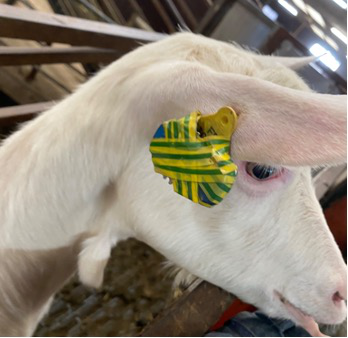
A pipeline with pre-processing options to detect behaviour from accelerometer data using Machine Learning tested on dairy goats.Sarah Mauny, Joon Kwon, Nicolas C. Friggens, Christine Duvaux-Ponter, Masoomeh Taghipoor https://doi.org/10.5281/zenodo.12627197Introducing a feature extraction method and implementing a gradient boosting algorithm to predict behavioral traits in animalsRecommended by Seyed Abbas Rafat based on reviews by 2 anonymous reviewers based on reviews by 2 anonymous reviewers
In the livestock industry, the concerns of society and livestock farmers have changed in recent decades, moving from a focus solely on production traits to sustainable production while respecting animal welfare (Ducrot et al., 2024). Animal behavior parameters can serve as a reliable proxy for animal welfare, but collecting large data sets of behavioral data on farm is very time-consuming when not automatized. Accelerometers are promising devices to detect animal behavior. A key element of the efficiency of the prediction of animal behavior from accelerometer data is the adequacy of pre-processing methods (Riaboff et al., 2019,Riaboff et al., 2022, Vidal et al., 2023). The article of Mauny et al., (2025) aims to find a solution for using huge automatized data. So, livestock farmers can effectively use new technologies to monitor animal behavior and then correct poor husbandry routines. Authors used the pipeline ACT4Behav - (Accelerometer-based Classification Tool for identifying Behaviours) - (Mauny et al., 2024) for the pre-processing of accelerometer data with the aim of selecting the most important features of dairy goats related to rumination, head in the feeder, lying and standing (using data based on video recordings for the validation of behavior activity). Mauny et al., (2025) established a clear methodology that systematically obtain the best features and processing techniques to predict each targeted variable from raw accelerometer data. The work provides valuable information for both animal husbandry specialists and data mining scientists. The main limitation of the work is the small number of animals for both training and model testing. References Ducrot C, Barrio MB, Boissy A, Charrier F, Even S, Mormède P, Petit S, Pinard-van der laan M-H, Schelcher F, Casabianca F, Ducos A, Foucras G, Guatteo R, Peyraud J-L, Vayssier-Taussat M, Veysset P, Friggens NC and Fernandez X. 2024. Animal board invited review: Improving animal health and welfare in the transition of livestock farming systems: Towards social acceptability and sustainability. animal 18, 101100. https://doi.org/10.1016/j.animal.2024.101100 Mauny, S, Kwon J, Friggens NC, Duvaux-Ponter C, Taghipoor M. 2024. ACT4Behav (Accelerometer-based Classification Tool for identifying Behaviours): a Machine Learning pipeline with extensive pre-processing and feature creation options. Zenodo. https://doi.org/10.5281/zenodo.12624796 Mauny S, Kwon J, Friggens NC, Duvaux-Ponter C, Taghipoor M. 2025. A pipeline with pre-processing options to detect behaviour from accelerometer data using Machine Learning tested on dairy goats.. Zenodo, ver. 6 peer-reviewed and recommended by PCI Animal Science. https://doi.org/10.5281/zenodo.12627197 Riaboff L, Aubin S, Bédère N, Couvreur S, Madouasse A, Goumand E, Chauvin A, Plantier G. 2019. Evaluation of pre-processing methods for the prediction of cattle behaviour from accelerometer data. Computers and Electronics in Agriculture 165, 104961. https://doi.org/10.1016/j.compag.2019.104961 Riaboff L, Shalloo L, Smeaton AF, Couvreur S, Madouasse A, Keane MT. 2022. Predicting livestock behaviour using accelerometers: A systematic review of processing techniques for ruminant behaviour prediction from raw accelerometer data. Computers and Electronics in Agriculture 192, 106610. https://doi.org/10.1016/j.compag.2021.106610 Vidal G, Sharpnack J, Pinedo P, Tsai IC, Lee AR, Martínez-López B. 2023. Impact of sensor data pre-processing strategies and selection of machine learning algorithm on the prediction of metritis events in dairy cattle. Preventive Veterinary Medicine 215, 105903. https://doi.org/10.1016/j.prevetmed.2023.105903
| A pipeline with pre-processing options to detect behaviour from accelerometer data using Machine Learning tested on dairy goats. | Sarah Mauny, Joon Kwon, Nicolas C. Friggens, Christine Duvaux-Ponter, Masoomeh Taghipoor | <p style="text-align: justify;">Animal behaviour is a significant component in the evaluation of animal welfare. Conducting continuous observations of animal behaviour is a time-consuming task and may not be feasible over extended periods for all ... |  | Animal behaviour , Animal welfare, Precision livestock farming, Small ruminants | Seyed Abbas Rafat | 2024-07-04 12:45:42 | View | |
13 Mar 2025
Shade use, welfare and performance of ewes grazing in temperate silvopastures differing in tree densityCécile Ginane, Mickaël Bernard, Véronique Deiss, Donato Andueza, Camille Béral https://doi.org/10.5281/zenodo.10974491Provision of optimal shade for ewes: a question of choiceRecommended by Birte L Nielsen based on reviews by Matteo Chincarini and Pol Llonch based on reviews by Matteo Chincarini and Pol Llonch
As the world slowly (or not so slowly) warms, the ability to regulate heat becomes even more pertinent for livestock kept in enclosed areas. Trees are not always present on land grazed by sheep, and when the pasture has some forestation, the coverage will provide varying degrees of shade. In this study by Ginane et al. (2025), ewes kept in enclosures with different levels of tree cover were observed at different times over a period of three years to investigate the extent to which the animals chose to spend time in the shade. By using fields with very different provision of shade (approximately 1, 40, and 81% shade, respectively), the authors wanted to test the hypothesis that ewes would actively seek out tree shade when the combined temperature and humidity increased – especially if the conditions reached levels associated with heat stress. Even at the lowest provision of shade, which consisted of a single tree in the paddock, all ewes could fit within the shade cast by the tree; but if the distribution of ewes or groups of ewes were random, i.e. independent of shade, the likelihood of these ewes being in the shade by chance was effectively 1%. By factoring in the element of chance, the authors found that mean shade use was greater than the tree canopy cover for the low and medium shade treatments, whereas it didn’t differ from chance for the densely forested treatment. Across treatments, all ewes spent just under 60% of the observation time grazing, and the ewes with the low and medium level of shade actively selected shade for foraging activity, whereas the ewes with over 80% canopy cover avoided it. Across treatments, shade was used primarily for resting and ruminating. Tree cover affected the availability of forage in a negative manner, with more biomass available for ewes in the low shade treatment and significantly less in the high treatment, although this did not translate into significant differences in live weight or body condition score. Using this information, Ginane et al. (2025) calculated the optimal level of tree cover to be somewhere between the low and medium cover, at roughly 30 trees per hectare – preferably spread out over the area to offer different locations of shade and to encourage a natural spread of manure. This longitudinal study of shade use by ewes provides novel and useful information on the positive and negative effects of tree cover in paddocks used to rear ewes with lambs. The authors raise the limitation of the study themselves, and they would have liked to also include observations on non-sunny days, to be able to eliminate place preferences independently of shade availability. But the clever calculation of active shade-selection makes this study easily applicable for use in the assessment of paddock suitability for pregnant ewes. References Cécile Ginane, Mickaël Bernard, Véronique Deiss, Donato Andueza, Camille Béral (2025) Shade use, welfare and performance of ewes grazing in temperate silvopastures differing in tree density. Zenodo, ver.4 peer-reviewed and recommended by PCI Animal Science https://doi.org/10.5281/zenodo.15001481 | Shade use, welfare and performance of ewes grazing in temperate silvopastures differing in tree density | Cécile Ginane, Mickaël Bernard, Véronique Deiss, Donato Andueza, Camille Béral | <p>The study aimed to objectify the importance of trees for sheep welfare by characterising how productive ewes, grazing in temperate mid-mountain pastures, use shade depending on climatic conditions and tree density. The impact of trees on sheep ... | Animal behaviour , Animal welfare, Grazing management , Small ruminants | Birte L Nielsen | 2024-04-03 11:39:54 | View | ||
06 Feb 2025
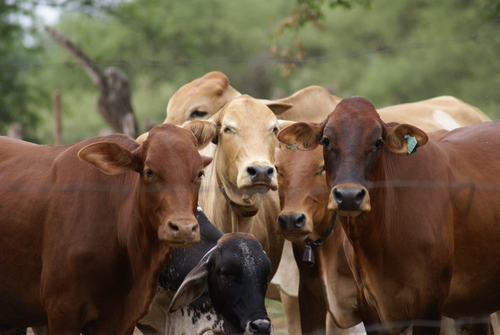
Preferred livestock interventions for small-scale farmers in the Great Limpopo Transfrontier Conservation Area: a demand-driven and participatory approachVimbai Gobvu, Sharai Ncube, Venancio E. Imbayarwo-Chikosi, Robin Bourgeois, Prisca H. Mugabe, Alexandre Caron https://hal.science/hal-04060712What kind of livestock interventions are relevant for small-scale farmers in Great Limpopo Transfrontier Conservation Area?Recommended by Anna Olsson based on reviews by 2 anonymous reviewers based on reviews by 2 anonymous reviewers
The predominant form of agriculture in sub-Saharan Africa is mixed crop and livestock production, typically in extensive systems characterised by low productivity and little input (Tui et al., 2021). Such extensive systems experience many challenges, including access to rangeland and other sources of livestock feed, loss of soil quality, increasingly unpredictable climate but also operational constraints such as access to markets and veterinary care. The work by Gobvu and collaborators (2025) addresses livestock farming sustainability specifically in the context of a Transfrontier Conservation Area (TFCA). A TFCA is defined as part of an ecological region reaching across boundaries of two or more countries and in which there are protected areas as well as resource use areas. TFCAs are founded to facilitate collective management of resources for the benefit of biodiversity as well as socio-economic development (SADC, 2025). Livestock farming in TFCAs face additional challenges arising from the tension between biodiversity protection and resource use, such as wildlife predation on livestock, competition between livestock and wildlife for feed and water as well as spread of infections between livestock and wild animals (Matseketsa et al., 2019; Caron et al., 2013; Cumming, 2011). The paper reports a study that was part of a larger project (EU-ProSuLi project, Caron et al., 2022) aiming at promoting local development and well-being of residents in the Great Limpopo TFCA, with focus on the Sengwe Communal Area in Zimbabwe. The specific aim was to test a methodology for identifying interventions that are aligned with the needs of the local stakeholders (demand-driven interventions. Anticipatory scenario building in the context of workshops was used in combination with individual questionnaires. Community representatives (n=31) were purposefully selected for their expected ability to act as knowledge brokers. A team of 10 facilitators supported the discussion through plenary and group work sessions. The participants were asked to identify factors of change with impact on local community livelihood, and subsequently to vote to select the most influential factors. Different future states for the year 2038, resulting from the impact of the factors of change, were discussed. In a follow-up workshop, participants were asked to propose activities that would support the development towards the most desirable scenario. In addition, a questionnaire was distributed through semi-structured/structured interviews to 126 households in nine villages. Results were largely similar and complementary between the two approaches. Preferred interventions were: restocking herds with locally adapted breeds, training in livestock management, marketing support, feed development and value addition, loan schemes for investment in livestock production and support for animal health interventions to reduce the heavy disease burden. Whereas the participatory process is time consuming and requires considerable human resources, it is important to ensure locally relevant interventions are chosen, and it is in itself part of the process towards successful implementation of these interventions. The study is thoughtfully designed based on previous work by the authors. The paper is well written and has been further improved through the reviewer feedback and revision process. References Caron, A., Miguel, E., Gomo, C., Makaya, P., Pfukenyi, D.M., Foggin, C., Hove, T. and de Garine-Wichatitsky, M., 2013. Relationship between burden of infection in ungulate populations and wildlife/livestock interfaces. Epidemiology & Infection, 141 (7), pp.1522-1535. https://doi.org/10.1017/S0950268813000204 Caron, A., Mugabe, P., Bourgeois, R., Delay, E., Bitu, F., Ducrot, R., Fafetine, J., Fynn, R., Guerbois, C., Motsholapheko, M. and Daré, W., 2022. Social-ecological System Health in Transfrontier Conservation Areas to Promote the Coexistence Between People and Nature. One Health Cases. https://doi.org/10.1079/onehealthcases.2022.0005 Cumming, D. H. M. 2011. Constraints to conservation and development success at the wildlife-livestock-human interface in southern African transfrontier conservation areas: a preliminary review. Wildlife Conservation Society, New York. http://www.wcs-ahead.org/workinggrps_kaza.html Gobvu, V. Ncube, S. Imbayarwo-Chikosi, V.E., Bourgeois, R. Mugabe, P.H. and Caron A. 2025. Preferred livestock interventions for small-scale farmers in the Great Limpopo Transfrontier Conservation Area: a demand-driven and participatory approach. HAL, ver.5 peer-reviewed and recommended by PCI Animal Science. https://hal.science/hal-04060712 Matseketsa, G., Muboko, N., Gandiwa, E., Kombora, D.M. and Chibememe, G., 2019. An assessment of human-wildlife conflicts in local communities bordering the western part of Save Valley Conservancy, Zimbabwe. Global Ecology and Conservation, 20, p.e00737. https://doi.org/10.1016/j.gecco.2019.e00737 Tui, S.H.K., Descheemaeker, K., Valdivia, R.O., Masikati, P., Sisito, G., Moyo, E.N., Crespo, O., Ruane, A.C. and Rosenzweig, C., 2021. Climate change impacts and adaptation for dryland farming systems in Zimbabwe: a stakeholder-driven integrated multi-model assessment. Climatic Change, 168 (1-2), p.10. https://doi.org/10.1007/s10584-021-03151-8 South African Development Community. 2025. Transfrontier Conservation Areas. . Consulted 7 January 2025. https://www.sadc.int/pillars/transfrontier-conservation-areas
| Preferred livestock interventions for small-scale farmers in the Great Limpopo Transfrontier Conservation Area: a demand-driven and participatory approach | Vimbai Gobvu, Sharai Ncube, Venancio E. Imbayarwo-Chikosi, Robin Bourgeois, Prisca H. Mugabe, Alexandre Caron | <p>In southern Africa, residents of Transfrontier Conservation Areas (TFCAs), devoted to biodiversity conservation and local development and well-being, practice small-scale farming in semi-arid environments constrained by the presence of pr... |  | Agricultural sustainability, Cattle production | Anna Olsson | 2023-04-06 12:54:58 | View | |
06 Jan 2025
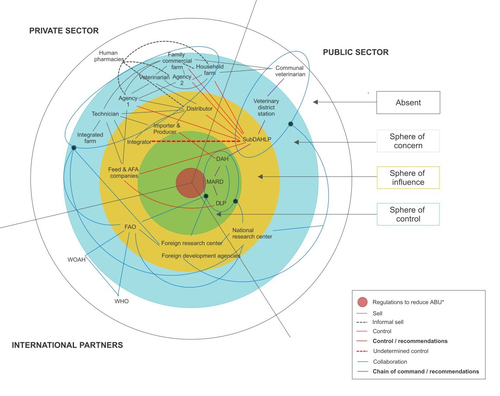
Understanding the implementation of antimicrobial resistance policies in Vietnam: a multilayer analysis of the veterinary drug value chainChloé Bâtie, Nguyen Van Duy, Nguyen Thi Minh Khue, Marisa Peyre, Marion Bordier, Nguyen Thi Dien, Vu Dinh Ton, Flavie Goutard https://doi.org/10.1101/2024.06.27.24309573Bridging the gap in antibiotic regulation within Vietnam's livestock sectorRecommended by François Meurens based on reviews by Rebecca Hibbard and 1 anonymous reviewer based on reviews by Rebecca Hibbard and 1 anonymous reviewer
The reduction of antibiotic use in livestock production, for the different species, has become a critical focus in national action plans across many countries, underscoring the urgent need to tackle this issue to preserve public health and combat antibiotic resistance (Xu et al., 2022; Jacobsen et al., 2023; Bava et al., 2024). Among these efforts, Vietnam's ambitious 2017 livestock plan is notable for its comprehensive regulatory framework aimed at controlling antibiotic use. This framework includes a phased ban on prophylactic antibiotics in animal feed and requires mandatory prescriptions for antibiotic access. Despite these promising regulations, their actual implementation poses significant challenges, with limited data available on their practical application. A recent study led by Batie and collaborators attempts to fill this knowledge gap by examining how these regulations are understood, accepted, and applied by stakeholders in the veterinary drug value chain in both northern and southern Vietnam (Batie et al., 2024). The study employed an interesting iterative stakeholder mapping and analysis approach, organizing a focus group in Hanoi with 12 participants and conducting 39 in-depth semi-structured interviews with a diverse range of stakeholders. These included government authorities, national research bodies, international partners, and private sector representatives. The qualitative analysis aimed to map the veterinary drug value chain, assess stakeholders' technical and social capital regarding regulations, and identify key factors influencing regulatory compliance. This research convincingly unveiled a complex network of 30 stakeholder categories and identified ten crucial factors that affect the implementation of regulations. These factors include stakeholders’ perceptions and understanding of the regulations, the availability of technical guidance, economic conflicts of interest, management inconsistencies, and hurdles such as technical and financial constraints, informal distribution channels, international influence, and consumer demand for safety. Additionally, the collective drive to reduce antibiotic resistance emerged as an influential factor. The comprehensive analysis reveals a pressing insight: although Vietnam's regulatory measures are essential for reducing antibiotic usage, their effectiveness is compromised by barriers such as inadequate local stakeholder involvement and various resource limitations. The study emphasizes the necessity for deeper engagement of local stakeholders in developing and refining these regulations. Furthermore, incorporating innovations from small producers into mainstream practices could be vital in overcoming current challenges. Nonetheless, the study acknowledges several limitations. Most interviews were conducted online owing to the health crisis—a much-needed format for time and budget constraints, albeit with some drawbacks such as reduced direct observations and potential information loss (Namey et al., 2019). The sensitivity of the subject may have led participants to withhold their true opinions, although the researchers attempted to mitigate this bias by interviewing multiple respondents from each category and gathering diverse perspectives. Notably, the study struggled to engage informal stakeholders, which could have enriched the description of the informal value chain. Constraints of time and resources meant that only a single representative from some stakeholder categories was interviewed, suggesting that interviewing additional parties, such as another veterinary district station, might have clarified roles within the drug value chain. The stakeholder identification was initially influenced by the researchers’ familiarity with the Vietnamese context; however, the iterative process helped address this limitation by recruiting new participants based on existing participants' knowledge. Additionally, translation issues may have introduced misunderstandings, potentially leading to an incomplete representation of the veterinary drug value chain, which reflects the situation as of data collection in 2021. For Vietnam to meet its policy objectives and contribute to the global endeavor against antibiotic resistance, it is crucial to reconcile stakeholder discrepancies and promote collaborative innovation. By fostering an inclusive environment for all parties, Vietnam can not only enhance regulatory adherence but also strengthen its commitment to sustainable and responsible livestock farming practices. The study is thoughtfully designed and skillfully executed. Additionally, the authors have made further improvements based on feedback from the journal. Readers will find the article both informative and engaging, providing valuable insights. I highly recommend this original article on the regulatory framework for controlling antibiotic use in Vietnam's livestock production systems. References Batie, C., Duy, N. V., Khue, N. T. M., Peyre, M., Bordier, M., Dien, N. T., et al. (2024). Understanding the implementation of antimicrobial resistance policies in Vietnam: a multilayer analysis of the veterinary drug value chain. medRxiv, 2024.06.27.24309573, ver. 2 peer-reviewed and recommended by Peer Community in Animal Science. https://doi.org/10.1101/2024.06.27.24309573 Bava, R., Castagna, F., Lupia, C., Poerio, G., Liguori, G., Lombardi, R., et al. (2024). Antimicrobial Resistance in Livestock: A Serious Threat to Public Health. Antibiotics 13, 551. https://doi.org/10.3390/antibiotics13060551 Jacobsen, A. B. J. E., Ogden, J., and Ekiri, A. B. (2023). Antimicrobial resistance interventions in the animal sector: scoping review. Front. Antibiot. 2. https://doi.org/10.3389/frabi.2023.1233698 Namey, E., Guest, G., O’Regan, A., Godwin, C. L., Taylor, J., and Martinez, A. (2019). How Does Mode of Qualitative Data Collection Affect Data and Cost? Findings from a Quasi-experimental Study. Field Methods. https://doi.org/10.1177/1525822X19886839 Xu, C., Kong, L., Gao, H., Cheng, X., and Wang, X. (2022). A Review of Current Bacterial Resistance to Antibiotics in Food Animals. Front Microbiol 13, 822689. https://doi.org/10.3389/fmicb.2022.822689
| Understanding the implementation of antimicrobial resistance policies in Vietnam: a multilayer analysis of the veterinary drug value chain | Chloé Bâtie, Nguyen Van Duy, Nguyen Thi Minh Khue, Marisa Peyre, Marion Bordier, Nguyen Thi Dien, Vu Dinh Ton, Flavie Goutard | <p>Reducing antibiotic use in livestock production has been a target for national action plans worldwide. The Vietnamese livestock plan issued in 2017 has, among other objectives, strengthened the regulatory framework for antibiotic use. While a p... |  | Animal epidemiology, Animal health, Farming systems, Veterinary epidemiology , Veterinary science | François Meurens | 2024-07-15 10:47:33 | View | |
07 Oct 2024
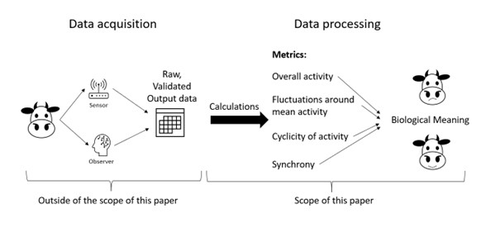
From data on gross activity to the characterization of animal behaviour: which metrics for which purposes?Ingrid D.E. van Dixhoorn, Lydiane Aubé, Coenraad van Zyl ,Rudi de Mol, Joop van der Werf, Romain Lardy, Marie Madeleine Mialon, Kees C.G. van Reenen, and Isabelle Veissier https://doi.org/10.5281/zenodo.10420600A guide to improving the use of activity data in animal researchRecommended by Matteo Chincarini based on reviews by Birte L Nielsen and Anna Olsson based on reviews by Birte L Nielsen and Anna Olsson
In production animals, behavioural activity plays a crucial role across a wide range of scientific disciplines and is often measured for various purposes depending on the field: ethology, animal welfare, reproduction, animal production, and so on. Historically, direct observation was the primary method of collecting such data, a process that was time-consuming and prone to possible observer bias. With the advent of automated systems and sensors, behavioural activity can now be recorded continuously and non-invasively, leading to a growing body of more reliable data (1). However, the lack of standardisation in how these data are calculated and interpreted has created challenges for cross-study comparisons. To fully harness the potential of studying behavioural activity, scientific studies must harmonise the methods used to calculate this measure. Standardising these methods would make it easier to compare results and identify possible gaps in knowledge. In the work by van Dixhoorn et al.(2), the authors examine the various metrics most commonly used to study behavioural activity. Through a series of examples, they address the definitions, calculation methods, and biological significance of metrics such as overall activity, fluctuations around mean activity, cyclicity of activity, and synchrony between animals. The authors suggest how these different metrics can be applied in specific contexts and guide readers in using appropriate terminology to ensure future studies are more easily comparable. In addition, by clarifying these concepts, the authors provide researchers with the tools to make informed decisions about which metric best suits their study's objectives. A key contribution of this work is its emphasis on standardising the metrics and terminology used in behavioural activity studies. Studies using different metrics may arrive at conclusions that appear contradictory, not because of actual differences in animal behaviour, but due to inconsistencies in how behaviour is quantified. By advocating for a common framework, the authors aim to improve the replicability of studies, facilitate meta-analyses, and allow for a more cohesive understanding of animal behaviour across different research groups. This, in turn, could accelerate the identification of key behavioural indicators, ultimately leading to better animal management practices and welfare assessments. This article provides a timely and valuable contribution to the field of animal science. As technology continues to evolve, so too must our methods for interpreting the vast amounts of data it generates (3). By ensuring that studies are comparable and data is interpreted consistently, the research community can work towards more meaningful discoveries in animal behaviour. I highly recommend this paper to researchers looking to deepen their understanding of activity metrics in animal behaviour studies. References 1. Rushen J, Chapinal N, de Passilé AM (2012). Automated monitoring of behavioural-based animal welfare indicators. Animal Welfare 21(3):339-50. https://doi.org/10.7120/09627286.21.3.339 2. van Dixhoorn IDE, Aubé L, van Zyl C, de Mol R, van der Werf J, Lardy R, Mialon MM, van Reenen CG, and Veissier I (2024). From data on gross activity to the characterization of animal behaviour: which metrics for which purposes?. Zenodo, 10420600, ver.5 peer-reviewed and recommended by PCI Animal Science. https://doi.org/10.5281/zenodo.10420600 3. Riaboff L, Shalloo L, Smeaton AF, Couvreur S, Madouasse A, Keane MT (2022). Predicting livestock behaviour using accelerometers: A systematic review of processing techniques for ruminant behaviour prediction from raw accelerometer data. Computers and Electronics in Agriculture 192:106610. https://doi.org/10.1016/j.compag.2021.106610 | From data on gross activity to the characterization of animal behaviour: which metrics for which purposes? | Ingrid D.E. van Dixhoorn, Lydiane Aubé, Coenraad van Zyl ,Rudi de Mol, Joop van der Werf, Romain Lardy, Marie Madeleine Mialon, Kees C.G. van Reenen, and Isabelle Veissier | <p>The behaviour of an animal is closely linked to its internal state. Various metrics can be calculated from activity data. Complex patterns of activity within or between individuals, such as cyclic patterns and synchrony, can inform on the biolo... |  | Animal behaviour , Animal health, Animal welfare, Precision livestock farming | Matteo Chincarini | 2023-12-21 23:36:35 | View | |
16 Sep 2024
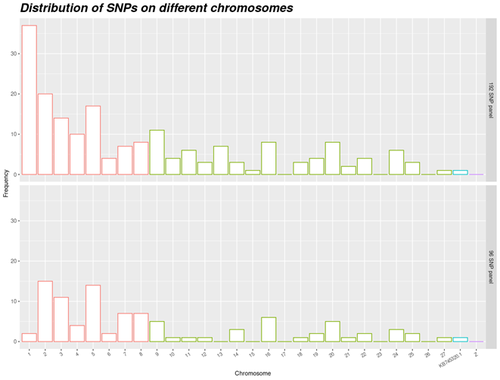
Cost-efficient assignment panel for ducks. Setup of a cost-efficient assignment panel for duck populations.Chapuis, Hervé, Brard-Fudulea, Sophie, Hazard, Azélie, Vignal, Alain, Demars, Julie, Rouger, Romuald, Teissier, Marc, Gilbert, Hélène https://hal.inrae.fr/hal-04542880Providing innovative genetic solutions to the future challenges of the poultry industry: extraction of a small-sized Single-nucleotide polymorphism (SNP) panel using factorial design for parentage assignment in a population consisting of pure and hybrid ducksRecommended by Seyed Abbas Rafat based on reviews by Arash Javanmard and 2 anonymous reviewers based on reviews by Arash Javanmard and 2 anonymous reviewers
One of the achievements of animal genetics is that it finds solutions along with the emergence of new needs of the animal husbandry community or the adoption of new laws. Muir and Cheng (2013) research serves as a classic example of using the innovations of animal genetics to meet new legal challenges, such as the restriction of beak cutting in laying hens. Muir and Cheng (2013) investigated the genetic diversity to deal with the cannibalism of intact chickens. In 2021, the European Citizens' Initiative urged the European Commission to legislate against the use of cages for farm animals in the livestock industry. Chapuis et al., (2024) presented a successful solution to the poultry industry about this (future) law by presenting a cost-efficient assignment SNP panel. In animal breeding, access to pedigree information is necessary for genetic progress. Since the 1970s, the development of genomic science and molecular techniques has shown their ability in this field. Despite the substantial reduction of genotyping costs in the last 20 years, the practical use of genome-wide genotyping for thousands of SNPs remains challenging. Therefore, the search for a small, cost-effective SNP panel is ongoing, with objectives including genetic diversity (Viale et al., 2017), product traceability (Dominik et al., 2021), species and hybrid identification (Harmoinen et al., 2021) and pedigree construction in wild populations (Ekblom et al., 2021). Furthermore, especially in recent decades, small panels of markers have been proposed for parentage assignment in different animals. For example, Domínguez-Viveros et al., (2020) developed panels with 42 to 63 markers for different sheep breeds in Mexico. Similar panels for parentage assignment have been proposed for salmon (May et al., 2020), rainbow trout (Liu et al., 2016), French sheep (Tortereau et al., 2017), Spanish sheep (Calvo et al., 2021), and European bison (Wehrenberg et al., 2024), with marker numbers of 142, 95, 180, 173, and 96, respectively. Massault et al., (2021) showed by simulation that a panel with at least 50 markers is sufficient for progeny assignment in pearl oysters. These examples highlight that extracting a small panel of markers (usually less than 200) from the total genotyping introduced in different species, can open new horizons for applying genomic information in animal breeding. Chapuis et al. (2024) addressed the challenge of finding an efficient set of markers that can be used in the hybridization of two species of the Pekin duck and the Muscovy duck. They used KASPar technology to setup a panel, with SNPs existing in both species and their hybrids. This panel has sufficient polymorphism to use in practice. Thus, it can be considered as a step forward compared to previous work done on microsatellites. A final list of SNPs was constructed from a reference set comprising 600 K genotyping of Anas platyrhynchos, Cairina moschata and mule duck. In addition to developing of a cost-efficient assignment panel, the work of Chapuis et al. (2024) presented a factorial design to maintain genetic diversity while considering specificities of duck production. The use of factorial design in avian pedigreed populations is relatively novel, making this research particularly innovative. The study's approach to factorial design in populations with limited size may be generalized to similar poultry species. Furthermore, sufficient effective size of population is selected. So, the panel can be used in other populations outside the tested populations. A notable feature of this panel is the use of neutral SNPs, which ensures that markers will not be lost due to future selection pressures over time. The paper of Chapuis et al. (2024) exemplifies the application of molecular genetics to address challenges in the poultry industry. The use of kinship matrix instead of relationship matrix, taking into account the unique characteristics of duck production, could be another novelty of the paper. According to the reviewers' comments, the results can be beneficial in the future, particularly with the introduction of the specific factorial design. References Calvo JH, Serrano M, Tortereau F, Sarto P, Iguacel LP, Jiménez MA, Folch J, Alabart JL, Fabre S and Lahoz B (2021). Development of a SNP parentage assignment panel in some North-Eastern Spanish meat sheep breeds. Spanish Journal of Agricultural Research 18, e0406. https://doi.org/10.5424/sjar/2020184-16805 Chapuis H, Brard-Fudulea S, Hazard A, Vignal A, Demars J, Rouger R, Teissier M, Gilbert H (2024). Cost-efficient assignment panel for ducks. Setup of a cost-efficient assignment panel for duck populations.: An illustration with experimental data. HAL, hal-04542880, ver. 2 peer-reviewed and recommended by Peer Community in Animal Science. https://hal.inrae.fr/hal-04542880 Domínguez-Viveros J, Rodríguez-Almeida FA, Jahuey-Martínez FJ, Martínez-Quintana JA, Aguilar-Palma GN, Ordoñez-Baquera P (2020). Definition of a SNP panel for paternity testing in ten sheep populations in Mexico, Small Ruminant Research ,193,106262. https://doi.org/10.1016/j.smallrumres.2020.106262 Dominik S, Duff CJ, Byrne AI, Daetwyler H, Reverter A (2021). Ultra-small SNP panels to uniquely identify individuals in thousands of samples. Animal Production Science 61, 1796–1800. https://doi.org/10.1071/AN21123 Ekblom R, Aronsson M, Elsner-Gearing F, Johansson M, Fountain T, Persson J (2021). Sample identification and pedigree reconstruction in Wolverine (Gulo gulo) using SNP genotyping of non-invasive samples. Conservation Genetics Resources 13, 261–274. https://doi.org/10.1007/s12686-021-01208-5 Harmoinen J, von Thaden A, Aspi J, Kvist L, Cocchiararo B, Jarausch A, Gazzola A, Sin T, Lohi H, Hytönen MK, Kojola I, Stronen AV, Caniglia R, Mattucci F, Galaverni M, Godinho R, Ruiz-González A, Randi E, Muñoz-Fuentes V, Nowak C (2021). Reliable wolf-dog hybrid detection in Europe using a reduced SNP panel developed for non-invasively collected samples. BMC Genomics 22, 473. https://doi.org/10.1186/s12864-021-07761-5 Liu S, Palti Y, Gao G, Rexroad CE (2016). Development and validation of a SNP panel for parentage assignment in rainbow trout. Aquaculture 452, 178–182. https://doi.org/10.1016/j.aquaculture.2015.11.001 Massault C, Jones DB, Zenger KR, Strugnell JM, Barnard R, Jerry DR (2021). A SNP parentage assignment panel for the silver lipped pearl oyster (Pinctada maxima). Aquaculture Reports 20, 100687. https://doi.org/10.1016/j.aqrep.2021.100687 May SA, McKinney GJ, Hilborn R, Hauser L, Naish KA (2020). Power of a dual-use SNP panel for pedigree reconstruction and population assignment. Ecology and Evolution 10, 9522–9531. https://doi.org/10.1002/ece3.6645 Muir WM, Cheng HW(2013). Genetics and the Behaviour of Chickens: Welfare and Productivity. In Genetics and the Behaviour of Domestic Animals. Vol. 2 (2nd ed.). pp. 1–30.ISBN: 9780128100165 Tortereau F, Moreno CR, Tosser-Klopp G, Servin B, Raoul J (2017). Development of a SNP panel dedicated to parentage assignment in French sheep populations. BMC Genetics 18, 50. https://doi.org/10.1186/s12863-017-0518-2 Viale E, Zanetti E, Özdemir D, Broccanello C, Dalmasso A, De Marchi M, Cassandro M (2017). Development and validation of a novel SNP panel for the genetic characterization of Italian chicken breeds by next-generation sequencing discovery and array genotyping. Poultry Science 96, 3858–3866. https://doi.org/10.3382/ps/pex238 Wehrenberg G, Tokarska M, Cocchiararo B, Nowak C (2024). A reduced SNP panel optimised for non-invasive genetic assessment of a genetically impoverished conservation icon, the European bison. Scientific Reports 14, 1875. https://doi.org/10.1038/s41598-024-51495-9
| Cost-efficient assignment panel for ducks. Setup of a cost-efficient assignment panel for duck populations. | Chapuis, Hervé, Brard-Fudulea, Sophie, Hazard, Azélie, Vignal, Alain, Demars, Julie, Rouger, Romuald, Teissier, Marc, Gilbert, Hélène | <p>The setup of a flexible and cost-effective 96-SNP assignment panel to be used in Pekin duck (<em>Anas platyrhynchos</em>), Muscovy duck (<em>Cairina moschata</em>) and their mule duck hybrid, is presented. SNP were selected on the available 600... |  | Animal genetics, Genomics | Seyed Abbas Rafat | 2024-04-12 09:45:59 | View | |
20 Aug 2024
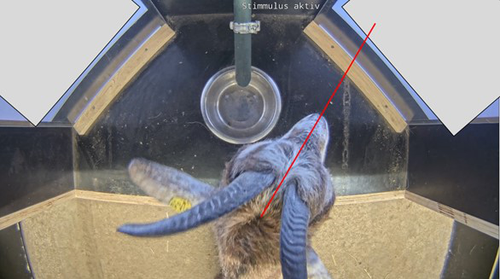
Goats who stare at video screens – assessing behavioural responses of goats towards images of familiar and unfamiliar con- and heterospecificsJana Deutsch, Steve Lebing, Anja Eggert, Christian Nawroth https://doi.org/10.31219/osf.io/d4nzkGazing behaviour as a tool to study goat cognitionRecommended by Isabelle Veissier based on reviews by Richard Bon and 1 anonymous reviewerMany cognitive studies use paradigms based on active decision-making, that require that animals are motivated to participate and interested in the reward (e.g. Rivas-Blanco et al., 2023). By contrast, looking time paradigms, in which the visual attention of an animal to a stimulus is measured, requires little training and little action from the subject, and can be used without reinforcement (e.g. Wilson et al., 2023). In this methodological paper, Jana Deutsch and her collaborators investigated the possibility of using a looking time paradigm to study perception and cognition in goats. The advantage of such a paradigm would be that it requires little training and can be used with no reinforcement. Goats were observed in front of two video screens presenting pictures of goats (familiar or not), of humans (familiar or not), or remaining white. The authors hypothesised that goats would pay more attention to pictures than to a white screen, would pay more attention to goats than to humans, and would discriminate familiar vs. unfamiliar beings. The goats had received previous positive contacts with the familiar humans. The goats were extensively habituated to the experimental set-up so that stress did not interfere in responses to testing. The stimuli were presented on the screens in a pseudorandomized and counterbalanced order. As hypothesised, goats looked longer at screen with pictures, and longer when the picture was that of another goat (familiar or not) than of a human being. Goats however did not seem to discriminate between familiar and unfamiliar being, or were equally motivated by the two types of beings. Ear postures were also recorded but did not show a relation with looking time and were not related to the type of picture shown on screens. Therefore, the authors argue that looking time but not ear posture is considered appropriate to test discrimination abilities or preferences in goats. More studies are needed to check if goats can differentiate familiar vs. unfamiliar beings. The experimental design is sound. The statistical analyses are rigorous and very relevant. The paper is clearly written. I recommend the manuscript for publication for its originality and its quality; In addition, the paper bring findings – that looking time is an adequate paradigm in goats to analyse how they pay attention to stimuli – that have potential impacts on further studies in animal cognition. References Deutsch, J., Lebing, S., Eggert, A., Nawroth, C. (2024). Goats who stare at video screens – assessing behavioural responses of goats towards images of familiar and unfamiliar con- and heterospecifics. OSF, ver.4 peer-reviewed and recommended by Peer Community In Animal Science. https://doi.org/10.31219/osf.io/d4nzk Rivas-Blanco, D., Monteiro, T., Virányi, Z., Range, F. (2024). Going back to “basics”: Harlow’s learning set task with wolves and dogs. Learning & Behavior. https://doi.org/10.3758/s13420-024-00631-6 Wilson, V. A. D., Bethell, E. J., Nawroth, C. (2023). The use of gaze to study cognition: limitations, solutions, and applications to animal welfare. Frontiers in Psychology, 14:1147278. https://doi.org/10.3389/fpsyg.2023.1147278
| Goats who stare at video screens – assessing behavioural responses of goats towards images of familiar and unfamiliar con- and heterospecifics | Jana Deutsch, Steve Lebing, Anja Eggert, Christian Nawroth | <p>Many cognitive paradigms rely on active decision-making, creating participation biases (e.g. subjects may lack motivation to participate in the training) and once-learned contingencies may bias the outcomes of subsequent similar tests. We here ... |  | Animal behaviour , Animal cognition, Animal welfare, Small ruminants | Isabelle Veissier | 2023-12-05 13:07:18 | View | |
24 May 2024
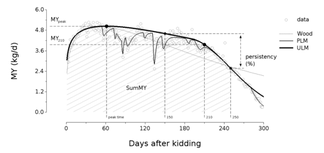
Diversity of performance patterns in dairy goats: multi-scale analysis of the lactation curves of milk yield, body condition score and body weightNicolas Gafsi, Olivier Martin, Fabrice Bidan, Bénédicte Grimard, Laurence Puillet https://doi.org/10.5281/zenodo.10101318Understanding milk and body reserves trajectories and nutrient partitioning in dairy goats through a modelling approachRecommended by Alberto Atzori based on reviews by Kristan Reed and 2 anonymous reviewersThe dairy sector is facing an historical period of high milk demand. However, increasing feed prices continually reduces the economic margins for farms. Managerial strategies to increase economical and technical awareness of animal performance, support the decision chain and optimize the use of production inputs are increasingly necessary, especially in goat farms with intensive production systems. Among the scientific goals, there is a particular emphasis on increasing knowledge about nutrition partitioning between milk production and body reserves — a topic that not easily addressed by nutritional models, limiting the attempts at production forecasting. The paper by Gafsi et al (2024) presents an interesting approach to studying phenotypic traits and trajectories of goat performance. It assesses the diversity of phenotypic trajectories reflecting functions such as milk production, body weight and condition score. This approaches aims to describe, understand and explore the interactions among biological functions and potential trade-offs of phenotypic trajectories across current and successive lactations. The work significantly contributes to the literature, particularly because previous descriptions of lactation curves relied primarily on mathematical outputs lacking information about the relationship among physiologically related variables. The analysis retrieved data from about 1500 goats over more than 20 years and was conducted with a multiscale approach. Data were fitted considering different types of models, including description of perturbations for lactation curves and with multiphasic models for the body weight and body condition score. Synthetic indicators were then estimated with a multivariate approach to define fitted trajectories and changes in performance.
Reference Gafsi N, Martin O, Bidan F, Grimard B, Puillet L (2024) Diversity of performance patterns in dairy goats: multi-scale analysis of the lactation curves of milk yield, body condition score and body weight. Zenodo. 10101318. ver.3 peer-reviewed and recommended by Peer Community In Animal Science. https://doi.org/10.5281/zenodo.10101318
| Diversity of performance patterns in dairy goats: multi-scale analysis of the lactation curves of milk yield, body condition score and body weight | Nicolas Gafsi, Olivier Martin, Fabrice Bidan, Bénédicte Grimard, Laurence Puillet | <p style="text-align: justify;">In the dairy goat sector, reduced longevity is a key issue leading to higher replacement rates in the herd and a poor dilution of doe rearing costs. There is a need to better understand the determinants of lifetime ... |  | Animal nutrition modelling, Lactation biology , Mathematical modelling, Physiology, Precision livestock farming, Small ruminants | Alberto Atzori | 2023-11-10 12:20:20 | View | |
15 Feb 2024
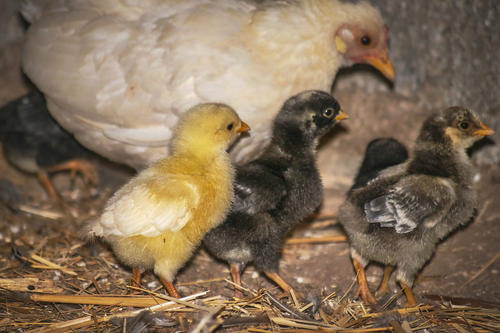
On-farm hatching and contact with adult hen post hatch induce sex-dependent effects on performance, health and robustness in broiler chickensL. A. Guilloteau, A. Bertin, S. Crochet, C. Bagnard, A. Hondelatte, L. Ravon, C. Schouler, K. Germain, A. Collin https://doi.org/10.1101/2023.05.17.541117The hen, the egg and the chick in conventional and on-farm hatching systemsRecommended by Florence Gondret based on reviews by Nicolas Bedere and Anna OlssonTo limit the use of antibiotics in the few days after hatching, it is necessary to improve the robustness of chicks during the early post-hatch period. This can be achieved by ensuring immediate access to feeds, optimizing the implantation and maturation of the microbiota and immune system of each chick, and minimizing exposure of stressors such as transportation. The study conducted by Guilloteau and colleagues (2024) compared the performance and health of chicks raised in conventional hatching systems with those raised in on-farm hatching systems. The authors showed that both systems yielded similar hatching percentage of eggs. Chicks from on-farm hatching systems exhibited higher body weights during the post-hatch period compared to those from conventional hatching, whereas health parameters were not affected by the system. An originality of the study was the examination of the benefits of the presence of an adult hen in hatching systems. The effects on chick traits were interpreted in relation to the hen behavior at hatching and a classification according to maternal or agonistic activities towards the chicks. However, the experimental design did not allow to make statistical correlations between hen behavior pattern and chick traits. Importantly, the presence of a hen decreased the hatching percentage, and this was likely associated with hen aggressiveness in the pen. The presence of the hen deteriorated the quality scores of the chicks in the on-farm hatching system, and increased mortality of chicks at hatching, negatively impacting chick weight gain and feed efficiency during the few days after hatching in both conventional and on-farm hatching systems. Thereafter, the effect of the presence of a hen on chick body weight was different according to the sex of the chicks and the type of hatching system. The presence of a hen did not reduce the parasitic load of the chicks nor improved clinical signs. No specific characterization of the fecal microbiota of the chicks was conducted, preventing the testing whether or not the presence of the hen affected the early implantation and maturation of the chick microbiome. Altogether, the data indicate that on-farm hatching systems are at least equivalent (in terms of health traits, feed efficiency) or even favorable (for faster growth in the early period after hatching) for chicks. Training the hens (considered as foster adults) to the presence of eggs and chicks or selecting hens according to specific activity behavioral patterns could be ways to establish better interactions between hens and chicks. Although the number and type of environmental stressors tested in the experiment differ from those in commercial farms, the article opens new perspectives for alternative hatching and farming practices. Reference Guilloteau LA, Bertin A, Crochet S, Bagnard C, Hondelatte A, Ravon L, Schouler C, Germain K, Collin A (2024) On-farm hatching and contact with adult hen post hatch induce sex-dependent effects on performance, health and robustness in broiler chickens. bioRxiv, 2023.05.17.541117. ver. 3 peer-reviewed and recommended by Peer Community in Animal Science. https://doi.org/10.1101/2023.05.17.541117.
| On-farm hatching and contact with adult hen post hatch induce sex-dependent effects on performance, health and robustness in broiler chickens | L. A. Guilloteau, A. Bertin, S. Crochet, C. Bagnard, A. Hondelatte, L. Ravon, C. Schouler, K. Germain, A. Collin | <p>To improve the early perinatal conditions of broiler chicks, alternative hatching systems have been developed. On-farm hatching (OFH) with an enriched microbial and stimulating environment by the presence of an adult hen is a promising solution... |  | Animal welfare, Farming systems, Poultry, Veterinary science | Florence Gondret | 2023-05-31 12:56:47 | View |
FOLLOW US
MANAGING BOARD
Karol B Barragán-Fonseca
Mohammed Gagaoua
Rachel Gervais
Florence Gondret
Francois Meurens
Rafael Muñoz-Tamayo*
Christian Nawroth
Seyed Abbas Rafat
Yuliaxis Ramayo-Caldas
* Representative









